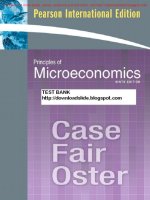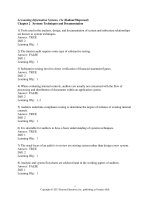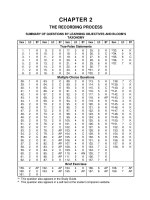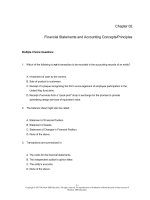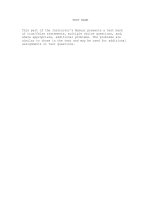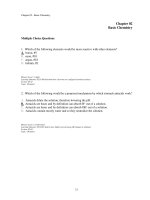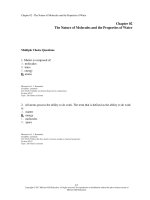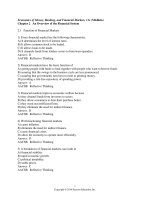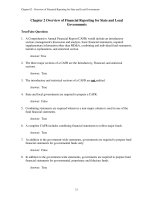Principles of microeconomics 11th edition case test bank
Bạn đang xem bản rút gọn của tài liệu. Xem và tải ngay bản đầy đủ của tài liệu tại đây (305.71 KB, 35 trang )
Principles of Microeconomics, 11e -TB1 (Case/Fair/Oster)
Chapter 2 The Economic Problem: Scarcity and Choice
2.1 Scarcity, Choice, and Opportunity Cost
1) The process by which resources are transformed into useful forms is
A) capitalization.
B) consumption.
C) production.
D) allocation.
Answer: C
Diff: 1
Topic: Scarcity, Choice, and Opportunity Cost
Skill: Definition
Learning Outcome: Micro-1
2) Outputs in the production process are
A) pollution.
B) money.
C) goods and services of value to households.
D) resources.
Answer: C
Diff: 1
Topic: Scarcity, Choice, and Opportunity Cost
Skill: Definition
Learning Outcome: Micro-1
3) Which of the following is NOT a resource as the term is used by economists?
A) land
B) labor
C) buildings
D) money
Answer: D
Diff: 1
Topic: Scarcity, Choice, and Opportunity Cost
Skill: Conceptual
AACSB: Reflective Thinking
Learning Outcome: Micro-1
1
Copyright © 2014 Pearson Education, Inc.
4) Which of the following would an economist classify as capital?
A) a $50 bill
B) a corporate bond
C) a post office employee
D) a guitar used by a musician
Answer: D
Diff: 2
Topic: Scarcity, Choice, and Opportunity Cost
Skill: Conceptual
AACSB: Reflective Thinking
Learning Outcome: Micro-1
5) Capital, as economists use the term,
A) is the money the firm spends to hire resources.
B) is money the firm raises from selling stock.
C) refers to the process by which resources are transformed into useful forms.
D) refers to things that have already been produced that are in turn used to produce other goods
and services.
Answer: D
Diff: 3
Topic: Scarcity, Choice, and Opportunity Cost
Skill: Definition
Learning Outcome: Micro-1
6) The concept of opportunity cost is based on the principle of
A) need.
B) consumption.
C) scarcity.
D) profit.
Answer: C
Diff: 1
Topic: Scarcity, Choice, and Opportunity Cost
Skill: Conceptual
AACSB: Reflective Thinking
Learning Outcome: Micro-20
7) The concept of trade-offs would become irrelevant if
A) we were dealing with a very simple, one-person economy.
B) poverty were eliminated.
C) scarcity were eliminated.
D) capital were eliminated.
Answer: C
Diff: 2
Topic: Scarcity, Choice, and Opportunity Cost
Skill: Conceptual
AACSB: Reflective Thinking
Learning Outcome: Micro-4
2
Copyright © 2014 Pearson Education, Inc.
8) Suppose you are deciding whether to spend your tax rebate check on a new iPod player or a
new digital camera. You are dealing with the concept of
A) equity.
B) comparative advantage.
C) opportunity costs.
D) the fallacy of composition.
Answer: C
Diff: 2
Topic: Scarcity, Choice, and Opportunity Cost
Skill: Conceptual
AACSB: Reflective Thinking
Learning Outcome: Micro-20
9) According to the theory of comparative advantage, specialization and free trade will benefit
A) only that trading party that has both an absolute advantage and a comparative advantage in
the production of all goods.
B) all trading parties, even when some are absolutely more efficient producers than others.
C) only that trading party that has an absolute advantage in the production of all goods.
D) only that trading party that has a comparative advantage in the production of all goods.
Answer: B
Diff: 2
Topic: Scarcity, Choice, and Opportunity Cost
Skill: Conceptual
AACSB: Reflective Thinking
Learning Outcome: Micro-3
Refer to the information provided in Table 2.1 below to answer the following questions.
Table 2.1
Writing Poems
Writing TV Commercials
Krystal
8
2
Mark
12
4
10) Refer to Table 2.1. For Krystal, the opportunity cost of writing one TV commercial is
A) 1/4 of a poem.
B) 2 poems.
C) 4 poems.
D) 6 poems.
Answer: C
Diff: 2
Topic: Scarcity, Choice, and Opportunity Cost
Skill: Analytical
AACSB: Analytic Skills
Learning Outcome: Micro-20
3
Copyright © 2014 Pearson Education, Inc.
11) Refer to Table 2.1. For Mark, the opportunity cost of writing one TV commercial is
A) 1/3 of a poem.
B) 2 poems.
C) 3 poems.
D) 8 poems.
Answer: C
Diff: 2
Topic: Scarcity, Choice, and Opportunity Cost
Skill: Analytical
AACSB: Analytic Skills
Learning Outcome: Micro-20
12) Refer to Table 2.1. Which of the following statements is true?
A) Krystal has a comparative advantage in both writing TV commercials and writing poems.
B) Mark has a comparative advantage in both writing TV commercials and writing poems.
C) Krystal has a comparative advantage in writing TV commercials, and Mark has a comparative
advantage in writing poems.
D) Mark has a comparative advantage in writing TV commercials, and Krystal has a comparative
advantage in writing poems.
Answer: D
Diff: 2
Topic: Scarcity, Choice, and Opportunity Cost
Skill: Analytical
AACSB: Analytic Skills
Learning Outcome: Micro-20
13) Refer to Table 2.1. To maximize total production,
A) Krystal should specialize in writing TV commercials, and Mark should specialize in writing
poems.
B) Mark should specialize in writing TV commercials, and Krystal should specialize in writing
poems.
C) Krystal and Mark should both split their time between writing poems and writing TV
commercials.
D) Krystal should write poems and write TV commercials, but Mark should only write poems.
Answer: B
Diff: 2
Topic: Scarcity, Choice, and Opportunity Cost
Skill: Analytical
AACSB: Analytic Skills
Learning Outcome: Micro-20
4
Copyright © 2014 Pearson Education, Inc.
14) Refer to Table 2.1. For Mark, the opportunity cost of writing six TV commercials is
________ poems made.
A) 2
B) 18
C) 24
D) an indeterminate number of
Answer: B
Diff: 2
Topic: Scarcity, Choice, and Opportunity Cost
Skill: Analytical
AACSB: Analytic Skills
Learning Outcome: Micro-20
15) Refer to Table 2.1. For Krystal, the opportunity cost of writing four TV commercials is
________ poems.
A) 2
B) 8
C) 16
D) 32
Answer: C
Diff: 2
Topic: Scarcity, Choice, and Opportunity Cost
Skill: Analytical
AACSB: Analytic Skills
Learning Outcome: Micro-20
16) According to the theory of comparative advantage, ________ raise(s) productivity by
lowering opportunity costs.
A) trade and specialization
B) investment in capital goods
C) economic growth
D) exchange and consumption
Answer: A
Diff: 2
Topic: Scarcity, Choice, and Opportunity Cost
Skill: Conceptual
AACSB: Reflective Thinking
Learning Outcome: Micro-3
5
Copyright © 2014 Pearson Education, Inc.
17) When two people trade,
A) both of them expect to be made worse off by the exchange.
B) they are trying to help out each other.
C) they know one of them will get the better of the other.
D) they both expect to be made better off by the exchange.
Answer: D
Diff: 2
Topic: Scarcity, Choice, and Opportunity Cost
Skill: Conceptual
AACSB: Reflective Thinking
Learning Outcome: Micro-20
18) Someone has a comparative advantage in producing a good if they can produce that good
A) in greater quantities.
B) at a lower opportunity cost.
C) using more capital and less labor.
D) using more labor and less capital.
Answer: B
Diff: 1
Topic: Scarcity, Choice, and Opportunity Cost
Skill: Conceptual
AACSB: Reflective Thinking
Learning Outcome: Micro-20
19) If someone has a comparative advantage in growing pineapples,
A) they can grow pineapples at a lower opportunity cost than other pineapple growers.
B) they also have an absolute advantage in growing pineapples.
C) they can grow more pineapples using the same resources than other pineapple growers.
D) pineapples are the only product they can grow.
Answer: A
Diff: 1
Topic: Scarcity, Choice, and Opportunity Cost
Skill: Conceptual
AACSB: Reflective Thinking
Learning Outcome: Micro-20
6
Copyright © 2014 Pearson Education, Inc.
20) Which of the following does NOT constitute an act of "investment" as economists use the
term?
A) The city council authorizes the construction of a new fire station.
B) A retiree buys 50 shares of stock at $10 a share and then sells the stock at a profit for $20 a
share.
C) An accountant attends a seminar on changes in the federal tax code.
D) A department store increases its inventory of football jerseys before the Super Bowl.
Answer: B
Diff: 2
Topic: Scarcity, Choice, and Opportunity Cost
Skill: Conceptual
AACSB: Reflective Thinking
Learning Outcome: Micro-1
21) In economics, investment always refers to
A) the act of buying stocks or bonds.
B) the creation of capital.
C) increasing the quantity of labor.
D) an increase in per capita output.
Answer: B
Diff: 1
Topic: Scarcity, Choice, and Opportunity Cost
Skill: Definition
Learning Outcome: Micro-18
22) The process of using resources to produce new capital is
A) research and development.
B) investment.
C) consumption.
D) economic growth.
Answer: B
Diff: 1
Topic: Scarcity, Choice, and Opportunity Cost
Skill: Definition
Learning Outcome: Micro-18
23) An example of forgoing present benefits in order to receive future benefits is
A) production.
B) saving.
C) consumption.
D) growth.
Answer: B
Diff: 1
Topic: Scarcity, Choice, and Opportunity Cost
Skill: Definition
Learning Outcome: Micro-18
7
Copyright © 2014 Pearson Education, Inc.
24) Because resources are scarce, the opportunity cost of investment in capital is
A) zero.
B) forgone future consumption.
C) forgone present consumption.
D) infinite.
Answer: C
Diff: 2
Topic: Scarcity, Choice, and Opportunity Cost
Skill: Conceptual
AACSB: Reflective Thinking
Learning Outcome: Micro-20
25) An example of an investment is
A) the purchase of a share of Google stock.
B) the purchase of an Exxon Mobil bond.
C) the purchase of a Hewlett Packard laser printer for use by a business.
D) all of the above.
Answer: C
Diff: 2
Topic: Scarcity, Choice, and Opportunity Cost
Skill: Conceptual
AACSB: Reflective Thinking
Learning Outcome: Micro-18
26) The opportunity cost of investment in capital is forgone present consumption because
A) capital takes a long time to produce.
B) capital increases the productivity of labor.
C) resources are scarce.
D) capital is an intangible good.
Answer: C
Diff: 2
Topic: Scarcity, Choice, and Opportunity Cost
Skill: Conceptual
AACSB: Reflective Thinking
Learning Outcome: Micro-20
27) If the unemployment rate increases from 10% to 14%, the economy will
A) move closer to a point on the ppf.
B) move away from the ppf toward the origin.
C) remain on the ppf.
D) remain on the origin.
Answer: B
Diff: 2
Topic: Scarcity, Choice, and Opportunity Cost
Skill: Conceptual
AACSB: Reflective Thinking
Learning Outcome: Macro-14
8
Copyright © 2014 Pearson Education, Inc.
28) Periods of less than full employment correspond to
A) points outside the ppf.
B) points underneath the ppf.
C) points on the ppf.
D) either points inside or outside the ppf.
Answer: B
Diff: 2
Topic: Scarcity, Choice, and Opportunity Cost
Skill: Conceptual
AACSB: Reflective Thinking
Learning Outcome: Micro-20
Refer to the information provided in Figure 2.1 below to answer the questions that follow.
Figure 2.1
29) Refer to Figure 2.1. Macroland is currently operating at Point A. The best explanation for this
is that
A) the economy has very poor technology.
B) the economy's resources are being used inefficiently.
C) the economy has very few resources.
D) the economy operates as an efficient market.
Answer: B
Diff: 2
Topic: Scarcity, Choice, and Opportunity Cost
Skill: Conceptual
AACSB: Reflective Thinking
Learning Outcome: Micro-19
9
Copyright © 2014 Pearson Education, Inc.
30) Refer to Figure 2.1. Macroland's production possibility frontier is bowed out from the origin
due to
A) decreasing opportunity costs.
B) trade.
C) unemployment.
D) specialized resources.
Answer: D
Diff: 2
Topic: Scarcity, Choice, and Opportunity Cost
Skill: Conceptual
AACSB: Reflective Thinking
Learning Outcome: Micro-20
31) Refer to Figure 2.1. The shape of Macroland's production possibility frontier shows
A) increasing opportunity costs.
B) constant opportunity costs.
C) decreasing opportunity costs.
D) random opportunity costs.
Answer: A
Diff: 2
Topic: Scarcity, Choice, and Opportunity Cost
Skill: Conceptual
AACSB: Reflective Thinking
Learning Outcome: Micro-20
32) The production possibility frontier is used to illustrate the concept of
A) the laissez-faire economy.
B) opportunity costs.
C) equilibrium.
D) aggregate demand.
Answer: B
Diff: 1
Topic: Scarcity, Choice, and Opportunity Cost
Skill: Conceptual
AACSB: Reflective Thinking
Learning Outcome: Micro-20
10
Copyright © 2014 Pearson Education, Inc.
Refer to the information provided in Figure 2.2 below to answer the questions that follow.
Figure 2.2
33) Refer to Figure 2.2. Point B represents a situation of
A) full employment but production inefficiency.
B) less than full employment but production efficiency.
C) both full resource employment and production efficiency.
D) less than full employment and production inefficiency.
Answer: C
Diff: 1
Topic: Scarcity, Choice, and Opportunity Cost
Skill: Conceptual
AACSB: Reflective Thinking
Learning Outcome: Micro-19
34) Refer to Figure 2.2. Microland is currently operating at Point B. You correctly deduce that
A) in Microland, all resources are fully employed and there are no production inefficiencies.
B) Microland has achieved a position of inefficiency.
C) Microland has recently experienced some type of technological breakthrough.
D) Microland has overcome the problem of scarcity.
Answer: A
Diff: 2
Topic: Scarcity, Choice, and Opportunity Cost
Skill: Analytical
AACSB: Analytic Skills
Learning Outcome: Micro-19
11
Copyright © 2014 Pearson Education, Inc.
35) The production possibility frontier is a graph that shows
A) all the combinations of goods and services that are consumed over time if all of society's
resources are used efficiently.
B) the amount of goods and services consumed at various average price levels.
C) the rate at which an economy's output will grow over time if all resources are used efficiently.
D) all the combinations of goods and services that can be produced if all of society's resources
are used efficiently.
Answer: D
Diff: 1
Topic: Scarcity, Choice, and Opportunity Cost
Skill: Definition
Learning Outcome: Micro-19
36) Production inefficiency occurs
A) only when an economy produces underneath its production possibility frontier.
B) only when an economy produces at the wrong point on the production possibility frontier.
C) either when an economy produces underneath the production possibility frontier or when the
economy is producing the wrong combination of goods on the production possibility frontier.
D) only when the economy produces outside the production possibility frontier.
Answer: A
Diff: 2
Topic: Scarcity, Choice, and Opportunity Cost
Skill: Conceptual
AACSB: Reflective Thinking
Learning Outcome: Micro-19
37) An economy that is producing on the production possibility frontier at some point other than
the output of efficient allocation is
A) efficient, as it is on the production possibility frontier.
B) inefficient, as the combination of goods and services produced is not what people want.
C) efficient, as the economy is producing goods at the lowest possible cost.
D) inefficient, as that combination of goods could be produced at a lower cost if more efficient
technology were employed.
Answer: B
Diff: 2
Topic: Scarcity, Choice, and Opportunity Cost
Skill: Conceptual
AACSB: Reflective Thinking
Learning Outcome: Micro-19
12
Copyright © 2014 Pearson Education, Inc.
38) If resources are combined efficiently in production, then the society
A) is producing at the most-desirable point on the production possibility frontier.
B) is producing at a point on the production possibility frontier but not necessarily at the mostdesirable point.
C) is producing at a point outside the production possibility frontier.
D) is experiencing economic growth.
Answer: B
Diff: 2
Topic: Scarcity, Choice, and Opportunity Cost
Skill: Conceptual
AACSB: Reflective Thinking
Learning Outcome: Micro-19
39) If an economy begins to use its resources more efficiently, it will move
A) closer to its ppf.
B) farther away from its ppf.
C) from a point along its ppf to a point outside its ppf.
D) from one point to another point along its ppf.
Answer: A
Diff: 2
Topic: Scarcity, Choice, and Opportunity Cost
Skill: Analytical
AACSB: Analytic Skills
Learning Outcome: Micro-19
40) The value of the slope of a society's production possibility frontier is called its
A) marginal rate of substitution.
B) inflation rate.
C) unemployment rate.
D) marginal rate of transformation.
Answer: D
Diff: 1
Topic: Scarcity, Choice, and Opportunity Cost
Skill: Definition
Learning Outcome: Micro-19
41) The marginal rate of transformation is the
A) slope of the production possibility frontier.
B) dollar value of the best forgone alternative.
C) process of using resources to produce new capital.
D) transformation of resources into a form that is useful to people.
Answer: A
Diff: 1
Topic: Scarcity, Choice, and Opportunity Cost
Skill: Definition
Learning Outcome: Micro-19
13
Copyright © 2014 Pearson Education, Inc.
Refer to the information provided in Figure 2.3 below to answer the questions that follow.
Figure 2.3
42) Refer to Figure 2.3. Assume that in this society the marginal rate of transformation of
sailboats for surfboards is constant and equal to -10. A graph of this society's production
possibility frontier will be represented by
A) A.
B) B.
C) C.
D) D.
Answer: C
Diff: 2
Topic: Scarcity, Choice, and Opportunity Cost
Skill: Conceptual
AACSB: Reflective Thinking
Learning Outcome: Micro-19
14
Copyright © 2014 Pearson Education, Inc.
43) Refer to Figure 2.3. Assume that in this society the opportunity cost of sailboats in terms of
surfboards is increasing. A graph of this society's production possibility frontier will be
represented by
A) A.
B) B.
C) C.
D) D.
Answer: A
Diff: 2
Topic: Scarcity, Choice, and Opportunity Cost
Skill: Conceptual
AACSB: Reflective Thinking
Learning Outcome: Micro-20
44) Refer to Figure 2.3. The law of ________ opportunity costs is best depicted by the
production possibilities frontier in panel A.
A) increasing
B) constant
C) decreasing
D) zero
Answer: A
Diff: 2
Topic: Scarcity, Choice, and Opportunity Cost
Skill: Conceptual
AACSB: Reflective Thinking
Learning Outcome: Micro-20
45) A society can produce two goods: donuts and beer. The society's production possibility
frontier is negatively sloped and "bowed outward" from the origin. As this society moves down
its production possibility frontier, producing more and more units of donuts, the opportunity cost
of producing beer
A) decreases.
B) remains constant.
C) increases.
D) could decrease or increase depending on the technology.
Answer: C
Diff: 2
Topic: Scarcity, Choice, and Opportunity Cost
Skill: Conceptual
AACSB: Reflective Thinking
Learning Outcome: Micro-20
15
Copyright © 2014 Pearson Education, Inc.
Refer to the information provided in Figure 2.4 below to answer the questions that follow.
Figure 2.4
46) According to Figure 2.4, the point where only motorcycles are produced is
A) A.
B) B.
C) C.
D) E.
Answer: D
Diff: 2
Topic: Scarcity, Choice, and Opportunity Cost
Skill: Analytical
AACSB: Analytic Skills
Learning Outcome: Micro-20
47) According to Figure 2.4, the optimal point for the economy is
A) A.
B) B.
C) F.
D) indeterminate from the information given.
Answer: D
Diff: 2
Topic: Scarcity, Choice, and Opportunity Cost
Skill: Analytical
AACSB: Analytic Skills
Learning Outcome: Micro-20
16
Copyright © 2014 Pearson Education, Inc.
48) According to Figure 2.4, which point cannot be produced with the current state of
technology?
A) A
B) B
C) C
D) F
Answer: D
Diff: 2
Topic: Scarcity, Choice, and Opportunity Cost
Skill: Analytical
AACSB: Analytic Skills
Learning Outcome: Micro-20
49) According to Figure 2.4, the point where only hybrid cars are produced is
A) A.
B) B.
C) C.
D) D.
Answer: A
Diff: 2
Topic: Scarcity, Choice, and Opportunity Cost
Skill: Analytical
AACSB: Analytic Skills
Learning Outcome: Micro-20
50) According to Figure 2.4, a decrease in unemployment may be represented by the movement
from
A) B to A.
B) B to D.
C) C to D.
D) A to C.
Answer: C
Diff: 2
Topic: Scarcity, Choice, and Opportunity Cost
Skill: Analytical
AACSB: Analytic Skills
Learning Outcome: Micro-20
17
Copyright © 2014 Pearson Education, Inc.
51) According to Figure 2.4, as the economy moves from Point A to Point E, the opportunity cost
of motorcycles, measured in terms of hybrid cars,
A) decreases.
B) increases.
C) remains constant.
D) initially increases, then decreases.
Answer: B
Diff: 2
Topic: Scarcity, Choice, and Opportunity Cost
Skill: Analytical
AACSB: Analytic Skills
Learning Outcome: Micro-20
52) According to Figure 2.4, as the economy moves from Point E to Point A, the opportunity cost
of hybrid cars, measured in terms of motorcycles,
A) increases.
B) decreases.
C) remains constant.
D) initially increases, then decreases.
Answer: A
Diff: 2
Topic: Scarcity, Choice, and Opportunity Cost
Skill: Analytical
AACSB: Analytic Skills
Learning Outcome: Micro-20
53) Refer to Figure 2.4. The economy moves from Point A to Point D. This could be explained
by
A) a reduction in unemployment.
B) an improvement in technology.
C) an increase in economic growth.
D) a change in society's preferences for motorcycles versus hybrid cars.
Answer: D
Diff: 2
Topic: Scarcity, Choice, and Opportunity Cost
Skill: Analytical
AACSB: Analytic Skills
Learning Outcome: Micro-10
18
Copyright © 2014 Pearson Education, Inc.
Refer to the information provided in Figure 2.5 below to answer the questions that follow.
Figure 2.5
54) Refer to Figure 2.5. The economy is currently at Point A. The opportunity cost of moving
from Point A to Point B is the
A) 90 LCD televisions that must be forgone to produce 20 additional plasma televisions.
B) 30 LCD televisions that must be forgone to produce 60 additional plasma televisions.
C) 120 LCD televisions that must be forgone to produce 40 additional plasma televisions.
D) 30 LCD televisions that must be forgone to produce 20 additional plasma televisions.
Answer: D
Diff: 2
Topic: Scarcity, Choice, and Opportunity Cost
Skill: Analytical
AACSB: Analytic Skills
Learning Outcome: Micro-20
55) Refer to Figure 2.5. The marginal rate of transformation in moving from Point A to Point B is
A) -2/3.
B) -1.5.
C) -3.
D) -30.
Answer: B
Diff: 2
Topic: Scarcity, Choice, and Opportunity Cost
Skill: Analytical
AACSB: Analytic Skills
Learning Outcome: Micro-20
19
Copyright © 2014 Pearson Education, Inc.
56) Refer to Figure 2.5. For this economy to move from Point B to Point C so that an additional
20 plasma televisions could be produced, production of LCD televisions would have to be
reduced by
A) exactly 30.
B) fewer than 30.
C) more than 30.
D) exactly 60.
Answer: C
Diff: 3
Topic: Scarcity, Choice, and Opportunity Cost
Skill: Analytical
AACSB: Analytic Skills
Learning Outcome: Micro-20
57) Refer to Figure 2.5. The best point for society would be
A) Point C, as at this point there are approximately equal amounts of LCD and plasma
televisions being produced.
B) either Point B or Point C, as the total amount being produced at either of these points is
approximately the same.
C) at any of the labeled points, as all of the points represent an efficient allocation of resources.
D) indeterminate from this information, as we don't have any information about the society's
desires.
Answer: D
Diff: 2
Topic: Scarcity, Choice, and Opportunity Cost
Skill: Analytical
AACSB: Analytic Skills
Learning Outcome: Micro-20
58) If the opportunity costs of producing a good increase as more of that good is produced, the
economy's production possibility frontier will be
A) negatively sloped and "bowed inward" toward the origin.
B) negatively sloped and "bowed outward" from the origin.
C) a negatively sloped straight line.
D) a positively sloped straight line.
Answer: B
Diff: 2
Topic: Scarcity, Choice, and Opportunity Cost
Skill: Conceptual
AACSB: Reflective Thinking
Learning Outcome: Micro-20
20
Copyright © 2014 Pearson Education, Inc.
59) As you move down the production possibility frontier, the absolute value of the marginal rate
of transformation
A) increases.
B) decreases.
C) initially increases, then decreases.
D) initially decreases, then increases.
Answer: A
Diff: 3
Topic: Scarcity, Choice, and Opportunity Cost
Skill: Conceptual
AACSB: Reflective Thinking
Learning Outcome: Micro-20
60) As more of a good, such as television sets, is produced, the opportunity costs of producing it
increases. This most likely occurs because
A) as more of a good is produced, the inputs used to produce that good will increase in price.
B) consumers would be willing to pay higher prices for the good as more of the good is
produced.
C) resources are not equally well suited to producing all goods, and as more of a good is
produced, it is necessary to use resources less well suited to the production of that good.
D) as more of a good is produced, the quality of that good declines, and therefore the costs of
production increase.
Answer: C
Diff: 3
Topic: Scarcity, Choice, and Opportunity Cost
Skill: Conceptual
AACSB: Reflective Thinking
Learning Outcome: Micro-20
61) Economic growth may occur when
A) a society acquires new resources.
B) a society learns to produce more using existing resources.
C) the society begins to produce the combination of goods society wants most.
D) both A and B
Answer: D
Diff: 2
Topic: Scarcity, Choice, and Opportunity Cost
Skill: Conceptual
AACSB: Reflective Thinking
Learning Outcome: Micro-1
21
Copyright © 2014 Pearson Education, Inc.
Refer to the information provided in Figure 2.6 below to answer the questions that follow.
Figure 2.6
62) Refer to Figure 2.6. Economic growth is represented by a
A) shift from ppf2 to ppf1.
B) shift from ppf1 to ppf2.
C) movement along ppf1.
D) movement along ppf2
Answer: B
Diff: 2
Topic: Scarcity, Choice, and Opportunity Cost
Skill: Analytical
AACSB: Analytic Skills
Learning Outcome: Micro-2
63) Refer to Figure 2.6. An improvement in technology may be represented by a
A) shift from ppf2 to ppf1.
B) shift from ppf1 to ppf2.
C) movement along ppf2.
D) movement along ppf1.
Answer: B
Diff: 2
Topic: Scarcity, Choice, and Opportunity Cost
Skill: Analytical
AACSB: Analytic Skills
Learning Outcome: Micro-2
22
Copyright © 2014 Pearson Education, Inc.
64) Refer to Figure 2.6. Which of the following will shift an economy's production possibility
frontier from ppf1 to ppf2?
A) a decrease in unemployment
B) an increase in production efficiency
C) a change in consumers' tastes
D) an increase in the economy's capital stock
Answer: D
Diff: 2
Topic: Scarcity, Choice, and Opportunity Cost
Skill: Analytical
AACSB: Analytic Skills
Learning Outcome: Micro-2
65) Refer to Figure 2.6. Which of the following will NOT cause the production possibility
frontier to shift from ppf1 to ppf2?
A) the discovery of previously unknown oil fields
B) an improvement in technology
C) an increase in the stock of capital
D) a decrease in the unemployment rate
Answer: D
Diff: 2
Topic: Scarcity, Choice, and Opportunity Cost
Skill: Analytical
AACSB: Analytic Skills
Learning Outcome: Micro-20
66) Refer to Figure 2.6. Which of the following is most likely to shift the production possibility
frontier from ppf1 to ppf2?
A) a change in consumer tastes
B) the purchase of stocks on the New York Stock Exchange
C) moving resources from capital to consumer goods
D) an increase in the general educational level of the population
Answer: D
Diff: 2
Topic: Scarcity, Choice, and Opportunity Cost
Skill: Analytical
AACSB: Analytic Skills
Learning Outcome: Micro-2
23
Copyright © 2014 Pearson Education, Inc.
67) Refer to Figure 2.6. If the economy is at ppf1, a change in consumer preferences would be
shown by a
A) shift from ppf2 to ppf1.
B) movement along ppf1.
C) movement along ppf2.
D) shift from ppf1 to ppf2.
Answer: B
Diff: 2
Topic: Scarcity, Choice, and Opportunity Cost
Skill: Analytical
AACSB: Analytic Skills
Learning Outcome: Micro-2
68) During the Iraq War, many of Iraq's oil refineries were destroyed. This would best be
represented by a
A) movement down Iraq's production possibility frontier.
B) movement off Iraq's production possibility frontier to some point inside the frontier.
C) shift of Iraq's production possibility frontier toward the origin.
D) movement up Iraq's production possibility frontier.
Answer: C
Diff: 2
Topic: Scarcity, Choice, and Opportunity Cost
Skill: Analytical
AACSB: Analytic Skills
Learning Outcome: Micro-20
69) For an economy to produce at a point beyond its current ppf, the economy must
A) waste less.
B) be more efficient.
C) reduce inputs.
D) increase its resource base.
Answer: D
Diff: 2
Topic: Scarcity, Choice, and Opportunity Cost
Skill: Conceptual
AACSB: Reflective Thinking
Learning Outcome: Micro-20
24
Copyright © 2014 Pearson Education, Inc.
70) In terms of the production possibility frontier, an increase in productivity attributable to new
technology would best be shown by
A) a movement along the frontier.
B) the production possibility frontier shifting outward, away from the origin.
C) a movement from a point inside the frontier to a point on it.
D) a movement toward the origin.
Answer: B
Diff: 2
Topic: Scarcity, Choice, and Opportunity Cost
Skill: Conceptual
AACSB: Reflective Thinking
Learning Outcome: Micro-20
71) An improvement in technology will cause the
A) production possibility frontier to shift outward.
B) production possibility frontier to shift inward.
C) economy to move down the production possibility frontier.
D) economy to move closer to its production possibility frontier.
Answer: A
Diff: 1
Topic: Scarcity, Choice, and Opportunity Cost
Skill: Conceptual
AACSB: Reflective Thinking
Learning Outcome: Micro-20
72) Consider two countries, Japan and Malaysia. Japan devotes a smaller portion of its
production to capital. All other things equal, which of the following statements is most likely
true?
A) Japan is a poorer country than Malaysia.
B) Japan will move up its production possibility curve faster than Malaysia.
C) Malaysia is producing inside its production possibility frontier, whereas Japan is producing at
a point on its production possibility frontier.
D) Malaysia's production possibility frontier will shift up and out farther and faster than Japan's.
Answer: D
Diff: 3
Topic: Scarcity, Choice, and Opportunity Cost
Skill: Conceptual
AACSB: Reflective Thinking
Learning Outcome: Micro-20
25
Copyright © 2014 Pearson Education, Inc.
